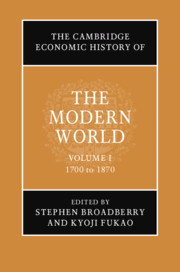Book contents
- The Cambridge Economic History of the Modern World
- The Cambridge Economic History of the Modern World
- The Cambridge Economic History of the Modern World
- Copyright page
- Contents
- Figures
- Tables
- Contributors to Volume I
- Preface and Acknowledgements
- Introduction to Volume I
- Part I Regional Developments
- 1 Britain, the Industrial Revolution, and Modern Economic Growth
- 2 Continental Europe
- 3 Tokugawa Japan and the Foundations of Modern Economic Growth in Asia
- 4 China: The Start of the Great Divergence
- 5 From the Mughals to the Raj: India 1700–1858
- 6 Sustainable Development in South East Asia
- 7 The Ottoman Empire, 1700–1870
- 8 The Economic History of North America, 1700–1870
- 9 Latin America: 1700–1870
- 10 Africa: Slavery and the World Economy, 1700–1870
- 11 Australia: Geography and Institutions
- Part II Factors Governing Differential Outcomes in the Global Economy
- Index
- References
8 - The Economic History of North America, 1700–1870
from Part I - Regional Developments
Published online by Cambridge University Press: 03 June 2021
- The Cambridge Economic History of the Modern World
- The Cambridge Economic History of the Modern World
- The Cambridge Economic History of the Modern World
- Copyright page
- Contents
- Figures
- Tables
- Contributors to Volume I
- Preface and Acknowledgements
- Introduction to Volume I
- Part I Regional Developments
- 1 Britain, the Industrial Revolution, and Modern Economic Growth
- 2 Continental Europe
- 3 Tokugawa Japan and the Foundations of Modern Economic Growth in Asia
- 4 China: The Start of the Great Divergence
- 5 From the Mughals to the Raj: India 1700–1858
- 6 Sustainable Development in South East Asia
- 7 The Ottoman Empire, 1700–1870
- 8 The Economic History of North America, 1700–1870
- 9 Latin America: 1700–1870
- 10 Africa: Slavery and the World Economy, 1700–1870
- 11 Australia: Geography and Institutions
- Part II Factors Governing Differential Outcomes in the Global Economy
- Index
- References
Summary
In 1700 about 250,000 European colonists and enslaved Africans lived in North America, primarily along a thin strip of land bordering the Atlantic Ocean. By 1870 these scattered colonial settlements had been consolidated into two continental nations – the United States and Canada – with a combined population of more than 40 million. Although agriculture remained the leading employer in North America in 1870, the rapid growth of industry was transforming these nations into increasingly urban and industrial societies and contributing to the accelerating growth of living standards. This chapter locates the sources of this remarkable growth in the interactions of abundant natural resources, a responsive economic and political system, and sustained technological progress. Yet the story of these years is not solely one of economic success. From the perspective of the aboriginal peoples of North America, European settlement and expansion had tragic consequences. So, too, the experience of enslaved Africans and their descendants was one of remarkable hardships. Slavery proved a source of continuing political tensions that resulted in a destructive and costly civil war and left a legacy of racial segregation and tensions that are still palpable today.
Keywords
- Type
- Chapter
- Information
- The Cambridge Economic History of the Modern World , pp. 193 - 218Publisher: Cambridge University PressPrint publication year: 2021

